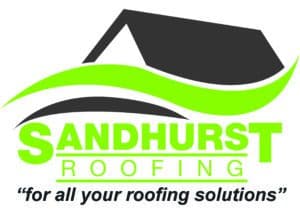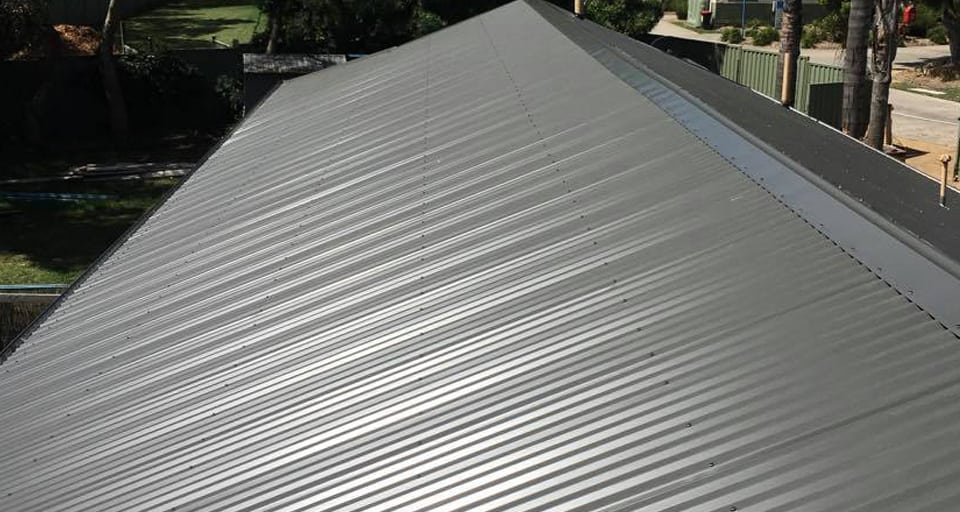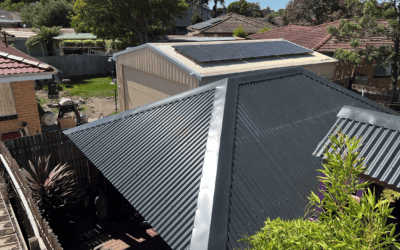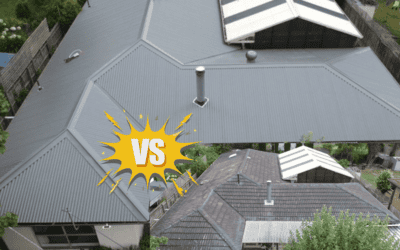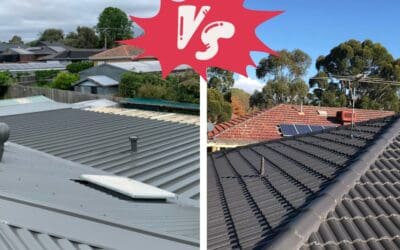When protecting your home, your roof is your first and most important line of defense. Choosing a roofing material that can withstand Australia’s diverse and extreme weather conditions is critical for homeowners and contractors alike. Australian homes face unique environmental challenges, from searing heatwaves to heavy storms and coastal corrosion.
This is where COLORBOND® steel roofing excels. Known for its durability, versatility, and resilience, it has become Australia’s gold roofing standard. But what makes COLORBOND® steel roofing so reliable? And how does it perform under extreme weather conditions compared to other materials like tiles? Let’s explore.
COLORBOND® steel Roofing Construction and Engineering
What Makes COLORBOND® steel Unique?
At the heart of COLORBOND® steel lies high-strength steel designed to handle Australia’s harsh climate. Its unique manufacturing process incorporates the following:
- A Steel Core: Provides unmatched durability and structural integrity.
- Advanced Paint Technology: Ensures the roof remains vibrant and resists fading, even under harsh UV exposure.
- Lightweight Design: Easier to install without compromising strength, making it an ideal choice for modern and traditional architectural styles.
Beyond its core build, every COLORBOND® steel sheet undergoes stringently engineered processes to withstand moisture, rust, and other environmental wear and tear.
Engineered for Extreme Conditions
COLORBOND® steel construction includes multiple protective layers:
- Corrosion Resistance: Special coatings like Zincalume protect against rust, making it especially suited for coastal environments.
- Thermal Reflective Properties:
COLORBOND® steel “Thermatech®” technology helps deflect heat, making homes more extraordinary and cutting energy costs.
- UV Resistance: Paint layers developed to stand firm against prolonged sun exposure without cracking or peeling.
This combination makes COLORBOND® steel a weather-resistant solution and a sustainable and long-term investment.
How COLORBOND® steel Roofing Performs in Extreme Weather
Australia’s unpredictable weather demands roofing materials that can adapt and endure various conditions. Here’s how COLORBOND® steel stands up to the challenge:
1. Intense Heat and Sun Exposure
COLORBOND® steel roofs are specifically designed to handle Australia’s brutal summer heat. With built-in reflective properties, they reduce the heat absorbed by your home, improving energy efficiency. Research shows that COLORBOND® steel roofs can lower roofing temperatures by up to 20%, making them more effective than traditional tiled roofs.
2. Heavy Rainfall and Storms
Frequent storms and torrential rain are common across Melbourne and much of Australia. The seamless, overlapping design of COLORBOND® steel sheets ensures water doesn’t seep through, a common issue with some tile systems—the anti-corrosive coating further guarantees long-term performance, even in areas with significant rainfall.
3. Hailstorms
Hailstorms can cause significant damage to traditional roof tiles, which may crack or shatter under impact. COLORBOND® steel strong structure offers excellent dent resistance compared to its tile counterparts, significantly reducing the chance of hail damage.
4. High Winds
Victoria, and primarily Melbourne, is no stranger to high winds. COLORBOND® steel’s secure fastening systems make it ideal for withstanding gusts of wind that would dislodge or damage heavier materials like tiles. Its lightweight construction minimizes strain on your home’s frame while offering unmatched grip and rigidity.
5. Coastal Environments
Salt corrosion can wreak havoc on many roofing materials. However, due to its protective coatings, COLORBOND® steel anti-salt corrosion properties make it exceptionally well-suited for coastal homes where salt-laden air could damage other types of roofs.
COLORBOND® steel vs. Tile Roofing in Extreme Weather
While tile roofing is also durable, it often falls short of COLORBOND® steel’s performance in extreme weather scenarios. Here’s a brief comparison:
Weight and Structural Considerations
- Colorbond: Lightweight and easy to install on various home styles, reducing the need for extensive structural support.
- Tiles: Heavy and require reinforced structures, leading to higher labor and installation costs.
Maintenance and Longevity
-
COLORBOND® steel: Virtually maintenance-free and resistant to most wear-and-tear issues, including moss and cracking.
- Tiles: Susceptible to cracks, moss build-up, and shifting during extreme weather, leading to frequent repairs.
Cost and Value
-
COLORBOND® steel: Though it may have a higher upfront cost in some cases, it offers long-term value by minimizing maintenance and repair costs.
- Tiles: While cheaper upfront, ongoing maintenance and repairs can significantly increase the cost over the roof’s lifecycle.
Beyond Durability – Additional Benefits of COLORBOND® steel Roofing
COLORBOND® steel roofing isn’t just durable and versatile, sustainable, and stylish. Here’s why it’s a favourite among homeowners:
- Aesthetic Versatility: Available in various colours, COLORBOND® steel roofs can match any design preference, from vibrant roofing designs to minimalist aesthetics.
- Sustainability: Made from recyclable materials, COLORBOND® steel roofs are an environmentally friendly option for eco-conscious homeowners.
- Noise Reduction: With proper insulation, COLORBOND® steel roofs successfully address potential concerns about noise, such as rain or hail.
- Backed by Warranties: Reputable manufacturers offer warranties, providing peace of mind for homeowners.
Real-Life Success Stories
At Sandhurst Roofing, we’ve seen countless examples of COLORBOND® steel roofing standing up to Melbourne’s toughest weather challenges. Whether battling high winds or coastal corrosion, COLORBOND® steel roofs have consistently exceeded expectations. Our satisfied customers often highlight the long-term value and reliability COLORBOND® steel adds to their homes.
One of our clients, Leah from Narre Warren, shared her experience:
“The team kept us informed from start to finish, and our new COLORBOND® steel roof looks fantastic and stood firm during a recent storm. I’d recommend COLORBOND® steel and Sandhurst Roofing to anyone!”
Expert Tips for Maximizing Your Roof’s Weather Resistance
Even the best roofs need proper care to ensure they last a lifetime. Here are some expert tips:
- Regular Inspections: Check your roof for any signs of wear and address them promptly. This is especially crucial after a storm.
- Professional Installation: To guarantee maximum durability, ensure your roof is installed or repaired by experienced professionals like Sandhurst Roofing.
- Invest in Insulation: The best insulation for COLORBOND® steel roofs will optimise thermal performance and noise reduction.
- Clean Gutters: Prevent water build-up by clearing debris regularly.
Why COLORBOND® steel Roofing is a Smart Choice for Extreme Weather
From Melbourne’s unpredictable rainstorms to Australia’s blistering heatwaves, COLORBOND® steel roofing has proven itself as the go-to choice for weather resistance. Durable, versatile, low-maintenance, and backed by years of research and innovation, it’s no wonder COLORBOND® steel reigns supreme among roofing materials.
If you’re ready to protect your home with COLORBOND® steel or want to learn more about the best options for your property, contact Sandhurst Roofing. Our expert team is here to guide you in selecting the perfect roof for Australia’s challenging weather conditions.
Your home deserves the best — choose COLORBOND® steel with Sandhurst Roofing.
